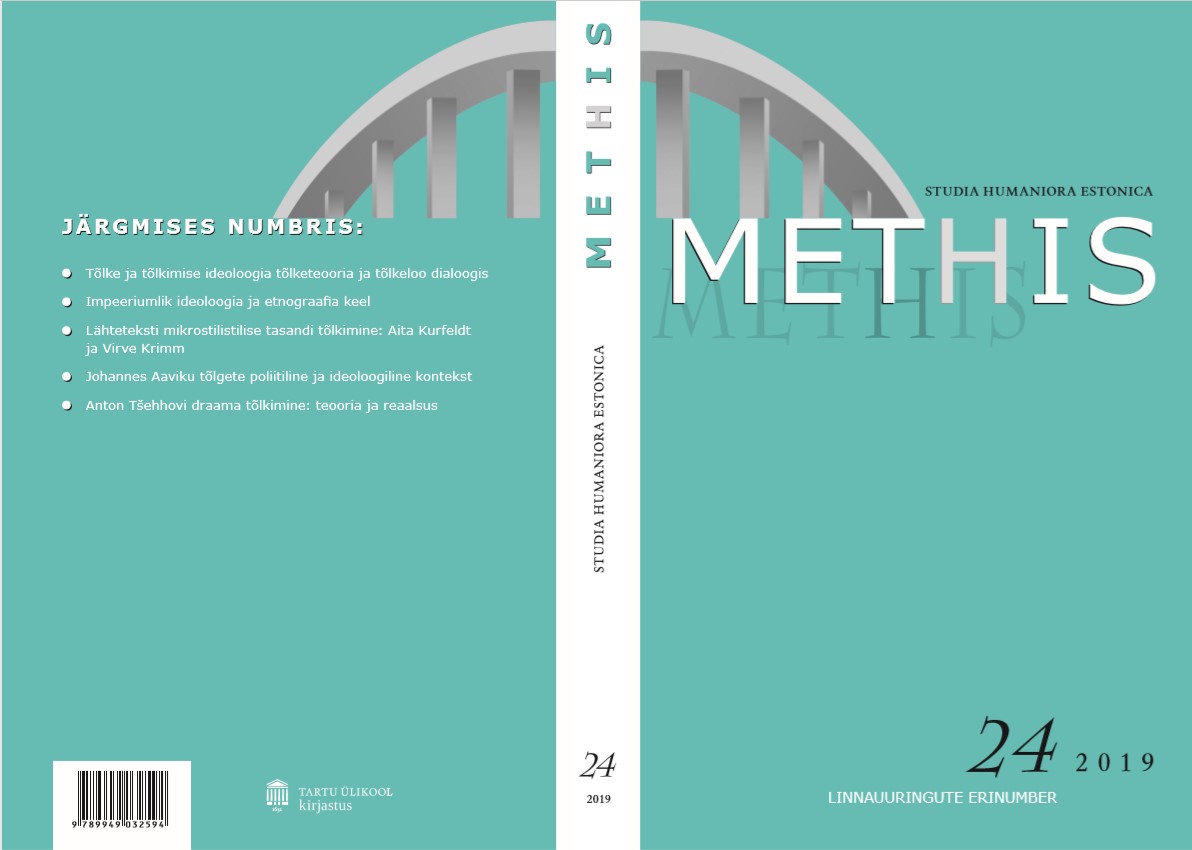Kreml ja Kreenholm, Talvepalee ja Toompea. Linnad stalinismiaja eesti luules / The Kremlin and Kreenholm, the Winter Palace and Toompea hill: Cities in Estonian Poetry of the Stalinist Era
DOI:
https://doi.org/10.7592/methis.v19i24.16199Keywords:
eesti luule, stalinism, sotsialistlik realism, linn, linnakirjandus, Estonian poetry, Stalinism, Socialist Realism, city, urban literatureAbstract
Artikkel käsitleb linnade kujutamist Nõukogude Eesti luules aastatel 1940–1955, analüüsimiseks on võetud sel ajal ilmunud luuleraamatud. Eestis kuulutati siis üldkehtivaks kirjanduslikuks meetodiks sotsialistlik realism. Esteetilised printsiibid kujunesid siiski kirjandusliku praktika käigus, sageli kirjutati luuletusi Moskvast ja Leningradist ning nende eeskujul õpiti kujutama ka kohalikke Eesti linnu eesotsas Tallinnaga. Linnaruum – nagu teisedki stalinistliku kultuuri komponendid – oli politiseeritud, mis tähendas esimeses järjekorras sakraliseeritud ruumimudeli ülekannet tekstidesse.
The article aims to give a survey of cities and urban spaces appearing in Soviet Estonian poetry of the Stalinist period. All in all, 93 Estonian-language collections of poetry were published in Soviet Estonia between 1940 and 1955, but not all of these contained urban topics. Estonia was occupied by the Soviet Union in 1940 and this brought about an abrupt change in literary texts produced in the country because literature had to take into account the regulations imposed by the doctrine of Socialist Realism and the personality cult of Joseph Stalin. In connection with this, representations of urban space became ideologised in a novel manner. It is difficult to tease forth explicit aesthetic prescriptions from the doctrine of Socialist Realism, but a unified aesthetics was developed in the course of literary practice by authors who copied one another in order not to err unwittingly. The political surveillance of literature increased at the turn of the 1940s and 1950s; it is in this period that the most pronounced standardisation of modes of representation can be observed.
Several cities are mentioned in Estonian poetry of the Stalinist era, but implicit rules governing the depiction of urban space become most readily evident in case of five cities. Among these were the largest cities in Russia (Moscow and Leningrad, today’s St. Petersburg) and in Estonia (Tallinn, Tartu and Narva). Depictions of Moscow and Tallinn are the most numerous. Representing Moscow is subject to rules in a particularly noticeable way: the capital of the Soviet Union had to contain the overarching spirit of Stalin and Lenin, and the city was represented as the static central point of a superpower or even of the whole world. In the city space of Moscow, Red Square with Lenin’s mausoleum and the Kremlin emerges as a sacralised space. In comparison with Moscow, the image of Leningrad is somewhat more dynamic for the city is often evoked as the starting point of the 1917 revolution, and Leningrad also appears as a city important in connection with World War II.
Representing Tallinn proceeded from the understanding that the capital of the Estonian SSR had to be an unmediated reflection of the power emanating from Moscow. The representations of Tallinn are more varied, though, for the authors more often tended to have a personal relationship with the city. The most important landmark emerging in representations of Tallinn is the medieval tower of Tall Hermann on Toompea hill that serves as the most important flag tower in Estonia. Even in Stalin-era poetry Tallinn was often perceived as ‘ancient’, (the epithet ‘old’ is repreated in many poems), which is partly paradoxical as the pathos of Socialist Realism would prefer to speak of the birth of new cities. The paradox was resolved by introducing a dialectics of ‘old’ and ‘young’ cities; solutions were also offered in the so-called poetry of reconstruction that encouraged the removal of wartime ruins and the erection of new buldings.
As concerns other Estonian cities, some poems focus on Narva as a significant industrial town. Tartu had been important in the earlier national history, but its significance waned now that Tallinn’s was rising. Tartu’s reputation as a university town survived into the Soviet period, however, and even the poetry of the Stalinist era contains some depictions of academic life. The urban centres of both Tartu and Narva suffered major damage in World War II, but the ruins receive only scant mention in verse. Still, they are not hidden and war is a recurring topic in the case of both cities.
Depiction of large cities, huge spatial elements and city centres suited the poetry of Stalin’s era. Small towns seemed meaningless in this context and outskirts only obtained a meaning in case events of the past were described – thus, slums, represented as the living quarters of workers close to the city limits, would harbour a revolutionary spirit. In the case of contemporary Soviet cities, the outskirts played no particular role, as all the politically favoured meanings were located in the centre.
A couple of publicatons specifically underscored the significance of cities, e.g the thematic anthology The Heart of the Homeland: Poetry Dedicated to Moscow by Estonian Authors (1947) and two books dedicated to Tallinn, Debora Vaarandi’s The Old Man from Lake Ülemiste and the Young City Builder (1952) and Paul Rummo’s A Letter from Tallinn (1955). The era’s most significant urban poets include Johannes Barbarus, Debora Vaarandi, Paul Rummo, Mart Raud, Ralf Parve and Vladimir Beekman. The modes of expression of these authors may vary, but their individual styles are less clearly expressed than is usual in poetry, because different authors’ styles became relatively uniform due to the canonised aesthetics of Socialist Realism.


